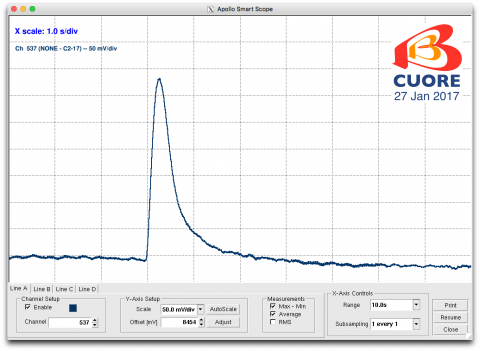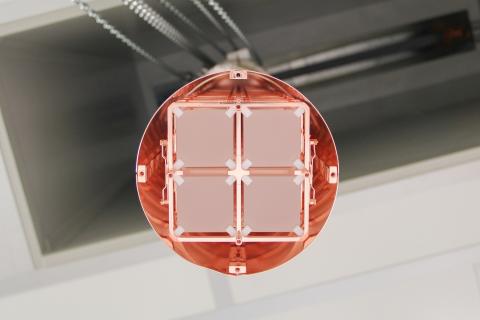Monday, January 30, 2017
We're very excited to announce a new milestone for our experiment: the CUORE detector has reached its operating temperature of 10 mK! This is over one ton of tellurium dioxide and copper cooled to a hundredth of a degree above absolute zero. We are now seeing clear signals from the detector, and our next phase is the optimization of our electronics and analysis software. Soon, we will begin taking official data, so stay tuned!
Thank you to all CUORE Collaborators, past and present, who have helped us reach this milestone!
Thursday, September 1, 2016
The CUORE experiment, located at the Gran Sasso National Laboratories (LNGS) of the National Institute of Nuclear Physics (INFN) in Italy, has completed the installation of 19 "towers" that make up the detector. The delicate and precise operation, which required dedicated efforts of specially trained teams of scientists, engineers, and technicians, and logistical support from the entire collaboration, was completed on August 26.
"All of the 19 towers that make up the detector, consisting of 988 Tellurium oxide crystals and weighing nearly 750 kg (1650 lbs), are now suspended from the coldest point of the experiment cryostat," said Oliviero Cremonesi, the experiment’s spokesperson. "Now the collaboration is preparing for the finishing touches to the system, and will then proceed in the coming months with the closure of the cryostat, the cooldown, and the start of science operations."
CUORE is an experiment designed to study the properties of neutrinos. In particular, the experiment looks for a rare phenomenon called neutrinoless double beta decay. Revealing this process would demonstrate a Majorana nature of neutrinos, providing a possible explanation for the prevalence of matter over antimatter in the universe. The experiment is an international collaboration of about 165 scientists from thirty institutions in Italy, USA, China, and France. CUORE is supported jointly by the Italian National Institute for Nuclear Physics (INFN) and the Department of Energy’s Office of Science and National Science Foundation in the US.
Thursday, December 10, 2015
On December 10, 2015, CUORE was featured on the first episode of "Innovation Place", produced by La Repubblica for Repubblica TV and narrated by Riccardo Luna. The subtitled video is below.
Thursday, April 23, 2015
CUORE was featured in the April edition of Symmetry Magazine. Read the article at symmetrymagazine.org.
Thursday, April 9, 2015
Press release at Berkeley Lab News Center
Today an international team of nuclear physicists announced the first scientific results from the Cryogenic Underground Observatory for Rare Events (CUORE) experiment. CUORE, located at the INFN Gran Sasso National Laboratories in Italy, is designed to confirm the existence of the Majorana neutrino, which scientists believe could hold the key to why there is an abundance of matter over antimatter. Or put another way: why we exist in this universe.
The results of the experiment, called CUORE-0, were announced at INFN Gran Sasso Laboratories (LNGS) in Italy, the U.S. Department of Energy's Lawrence Berkeley National Laboratory (Berkeley Lab), and at other institutions in the US.
The findings are twofold. First, the CUORE-0 results place some of the most sensitive constraints on the mass of the elusive Majorana neutrino to date. With these new constraints, the CUORE team is essentially shrinking the size of the haystack that hides the Majorana needle, making it much more likely to be found.
Second, the experiment, successfully demonstrates the performance of CUORE's novel design--a detector made of towers of Rubik's cube-sized crystals of tellurium dioxide. These towers are placed in a high-tech refrigerator that has been painstakingly decontaminated, shielded from cosmic rays, and cooled to near absolute zero.
Today's results represent data collected over two years from just one tower of tellurium dioxide crystals. By the end of the year, all 19 towers, each containing 52 crystals, will be online, increasing CUORE's sensitivity by a factor of 20.
"CUORE-0 is so far the largest detector operating at a temperature very close to absolute zero," says Dr. Oliviero Cremonesi of INFN-Milano Bicocca, spokesperson for the CUORE collaboration. "CUORE is presently in its final stages of construction, and when completed, it will study the nuclear processes associated with the Majorana neutrino with unprecedented sensitivity."
"With the CUORE-0 results, we've proven that our experimental design, materials, and processes, which include extremely clean surfaces, pure materials, and precision assembly, are paying off," says Yury Kolomensky, senior faculty scientist in the Physics Division at Berkeley Lab, professor of physics at UC Berkeley, and U.S. spokesperson for the CUORE collaboration.
Annihilations in the Early Universe
To pin down the Majorana neutrino, the researchers are looking for a telltale indicator, a rare nuclear process called neutrinoless double-beta decay. This process is expected to occur infrequently, if at all: less than once every septillion (a trillion trillion, or, a 1 followed by 24 zeros) years per nucleus.
Unlike regular double-beta decay, which emits two anti-neutrinos, neutrinoless double-beta decay emits no neutrinos at all. It's as if one of the anti-neutrinos has transformed into a neutrino and cancelled--or annihilated--its sibling inside the nucleus.
"In 1937, Ettore Majorana predicted that neutrinos and anti-neutrinos could be two manifestations of the same particle - in modern language, they are called Majorana particles," says Reina Maruyama, assistant professor of physics at Yale University, and a member of the CUORE Physics Board, which guided the analysis of the data. "Detecting neutrinoless double-beta decay would lead us directly to the Majorana particle, and give us hints as to why the universe has so much more matter than antimatter."
Known laws of physics forbid such matter-antimatter transformations for normal electrically charged particles like electrons and protons. But neutrinos, which are electrically neutral, may be a special kind of matter with special capabilities.
The proposed matter-antimatter transitions, while extraordinarily rare now, if they happen at all, may have been common in the universe just after the big bang. The remainder of existence, then, after all the annihilations, would be the matter-full universe we see today.
Crystal Clarity
The CUORE crystals of tellurium dioxide are packed with more than 50 septillion nuclei of tellurium-130, a naturally occurring isotope that can produce double-beta decay and possibly neutrinoless double-beta decay. For the experiment, the crystal towers sit in an extremely cold refrigerator called a cryostat that's cooled to about 10 milliKelvin or -273.14 degrees Celsius. Last year, the CUORE cryostat set a record for being the coldest volume of its size.
In the very cold CUORE crystals, presence of both nuclear processes would produce small but precisely measured temperature rises, observable by highly sensitive temperature detectors within the cryostat. These temperature increases correspond to spectra--essentially the amount of energy given off--from the nuclear event. Two-neutrino double-beta decay produces a broad spectrum. In contrast, neutrinoless double-beta decay would create a characteristic peak at the energy of 2528 kiloelectron-volts. This peak is what the researchers are looking for.
The CUORE experiment sits about a kilometer beneath the tallest mountain of the Apennine range in Italy, where rock shields it from cosmic rays. This location, as well as the experimental design, enables the sensitivity required to detect neutrinoless double-beta decay.
"The sensitivity demonstrated by the results today is outstanding," says Stefano Ragazzi, director of the INFN Gran Sasso National Laboratories. "The INFN Gran Sasso Laboratories offers a worldwide unique environment to search for ultra-rare interactions of Majorana neutrinos and dark matter particles and is proud to host the most sensitive experiments in these fields of research."
"While there's no direct evidence of the Majorana neutrino yet, our team is optimistic that CUORE is well positioned to find it," says Ettore Fiorini, professor emeritus of physics at the University of Milano-Bicocca and founding spokesperson emeritus of the experiment. "There is a competition of sorts, with other experiments using complementary techniques to CUORE turning on at about the same time. The next few years will be tremendously exciting."
CUORE is supported jointly by the Italian National Institute for Nuclear Physics Istituto Nazionale di Fisica Nucleare (INFN) in Italy, and the Department of Energy's Office of Science and the National Science Foundation in the US. The CUORE collaboration is made of 157 scientists from Italy, U.S., China, France, and Spain, and is based in the underground Italian facility called INFN Gran Sasso National Laboratories (LNGS) of the INFN.



